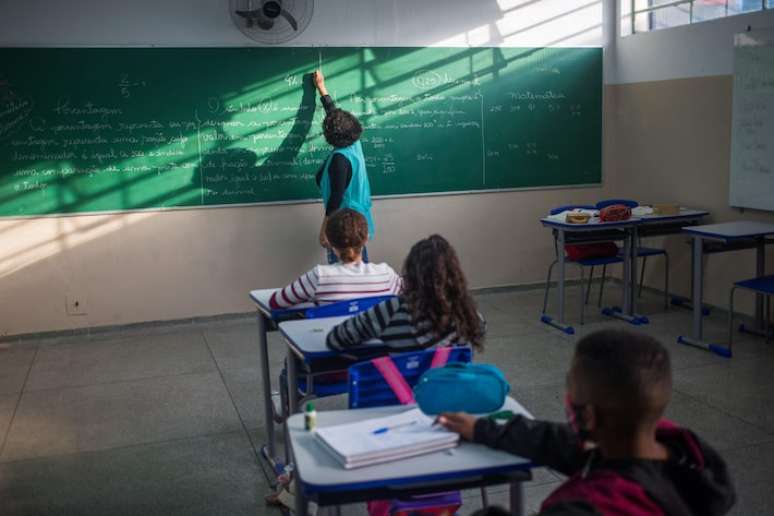The expert states that the MEC’s decision that the degree course is 50% in-person is correct
For education specialist and former global director of education at the World Bank Claudia Costinthe main challenges that Brazil faces in making the teaching profession attractive go far beyond the low salary and reach the very image that the teacher has in society, which, according to her, does not value him as a professional, but as someone who faces difficulties, for which people feel sorry.
Regarding the quality of training, Claudia sees the lack of “dialogue between theory and practice” in degree courses in general as a problem. And this becomes an even bigger challenge in a scenario where the majority of college student enrollments are for distance learning (EAD) courses. Claudia believes the Ministry of Education’s decision is right (MEC)which approved a resolution of the National Council of Education (CNE) so that distance learning degree courses have at least 50% in-person lessons. “Having 100% EAD teacher training doesn’t work.”
What are the main challenges the country faces today in training good teachers?
I think the first is the unattractiveness of the teaching career. It’s not attractive for three reasons. The first reason is the salary. And there is a second one that dialogues with this first one, which is the fragmentation of contracts. In other words, since Brazil, unlike other countries, has a four-hour school day, the teacher, especially those in primary and high schools, to complete a 40-hour week, ends up having to teach many times three or four schools. He does not teach, as in many countries, in a single school, having time to prepare the class and correct the work. Although legislation stipulates that a third of one’s time must be spent on extracurricular activities, this time is often spent traveling from one school to another. But the third reason, especially cruel, is that society, often the press itself, looks at the teacher with pity, not with professional respect or admiration. It is as if the teacher is not evaluated professionally, but as a human being facing challenges.
In Pisa (Program for International Student Assessment, which evaluates students internationally), when 15-year-old Brazilian students were asked what their dream profession was, one of the lowest percentages was to choose the profession of teacher. Because this student has the perception that the teaching profession is not perceived as admirable. Another challenge is that the training that teachers receive for one of the most complex professions does not include a dialogue between theory and practice, as exists, for example, in Medicine. In Medicine you learn the theory, but much of the doctor’s training takes place in the university hospital, observing the procedures, participating. Teacher training is unprofessional, as is the case for engineers and doctors. In other words, he is not prepared for the profession. A future mathematics teacher, for example, even in federal universities, often has three and a half years of mathematics and then an academic semester, four months, of history of education, philosophy of education, sociology of education. Bringing together students from different faculties, who will be teachers of Physics, Mathematics, History, in an often ritual academic and internship semester. This makes training very precarious compared to the challenge of training children and adolescents.
According to the 2023 Higher Education Census, 67% of undergraduate enrollees are taking distance learning courses. Why are these data considered worrying by education stakeholders?
In fact, the figure in public universities is 80% in attendance and in private universities, in new enrolments, it is 90% EAD. And for incoming students, those who enter the private network in their first year, it is 93.5%. In other words, if practice is so important to teacher education, imagine what distance learning practice is. I often criticize the MEC for decisions that I think don’t address the right things, but this time they’ve made two decisions that I think are going in the right direction. The first is to say that there will be 50% in-person teaching even in those who define themselves as EAD. I don’t think it’s wrong to envision distance learning in higher education. It depends on which course. No one would think about training doctors through distance learning. And the teacher plays as important a role as the doctor. The other MEC decision, little commented on by the press, concerns the Enade (National Student Performance Exam), which evaluates the student’s performance at the end of the course. In July it was decided that Enade will have two important prospects. First of all, the reference matrices, which establish what is required in the test, will pay much more attention to the evaluation of teaching skills, the ability to teach, than to the disciplinary contents of each course.
Returning to the example of the Mathematics teacher: there will be a part that will naturally concern Mathematics, but teaching competence will be much more important in the Mathematics degree, if he knows what is important for teaching Mathematics. There is also another decision (by the MEC) that there will be a new pattern in the exam which will cover internship. In other words, it is not enough for me to say that I have done the internship and have the signature of the school director. You will have to submit a portfolio of how you performed in class, what you observed in class, and things like that. I think this is going in the right direction and, if implemented correctly, will be a big step forward.
How do you see the resistance of the associations linked to the EAD to the resolution that establishes 50% of in-person lessons for teacher training? Do they say, for example, that distance learning is the only way for a poorer student to attend college?
They are right about this. It is true that in the world there is a university offer like in the United States, where there is a campus, a university life for young people and research is done there, but also a university for young people or adult workers. It’s important, but they don’t do it for Medicine. And, in most countries, they don’t do this for teacher training. Because these are professions that require practice. Is it important to have EAD? I have no doubts. Is it important to have a mixed program, how is it designed? Yes, you will be able to keep young people who work part of the time in college. You can organize their time. Several countries have intensive courses one week a month. They have hybrid models. Having 100% EAD teacher training doesn’t work, it doesn’t prepare teachers for their practice.
Recently, a study by FGV stated that Brazil has difficulty hiring qualified teachers, “as the best high school students are not encouraged” to enter the profession. How to encourage them?
Chile has a system inspired by something Finland did, which is this: value the profession by making it difficult to get there. So, in order to study a bachelor’s degree in Finland, you must have a very high grade in the equivalent of their Enem. And it worked. What did Chile do based on this experience? They pay a scholarship so that the best students can earn a degree. So you take the best high school students and they study on a scholarship almost equivalent to the starting salary they would earn as a teacher. This way you can attract them. And because teaching is full-time, on a 40-hour contract, the working conditions are much more attractive. I think this is the big agenda of the moment. We must teach full time, with the teacher preferably assigned to a single school, with training that allows us to attract the best to the profession.
Source: Terra
Rose James is a Gossipify movie and series reviewer known for her in-depth analysis and unique perspective on the latest releases. With a background in film studies, she provides engaging and informative reviews, and keeps readers up to date with industry trends and emerging talents.







